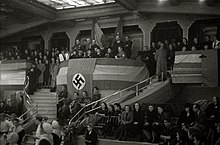The following is a timeline of the history of the city of San Sebastián, Spain.
This is a dynamic list and may never be able to satisfy particular standards for completeness. You can help by adding missing items with reliable sources.Prior to 20th century
- 1682 – Consulate of the Sea established.
- 1813

Storming of Saint Sebastian, Denis Dighton, 1813 - Siege of San Sebastián.
- 31 August: Fire destroys large part of city.
- 1817 – Konstituzio plaza [eu] constructed.
- 1832 – Udaletxe Zaharra (Donostia) [eu] (town hall) built.
- 1842 – Population: 10,036.
- 1843 – Teatro Principal (San Sebastián) [es] (theatre) opens.
- 1863 – City walls dismantled.
- 1872 – Diario de San Sebastián [eu] newspaper begins publication.
- 1874 – San Sebastián public library [eu] established.
- 1879 – Academia Municipal de Música [es] founded.
- 1880
- Escuela de Artes y Oficios de San Sebastián (school) opens.
- Euskal-Erria [eu] magazine begins publication.
- Parque Alderdi Eder [es] (garden) established.
- 1886
- Compañía del Tranvía de San Sebastián [es] established.
- Spanish royal court begins summering at San Sebastian.
- 1887 – Gran Casino de San Sebastián [es] built.
- 1893 – Miramar Palace built.
- 1897
- Cathedral of the Good Shepherd consecrated.
- Orfeón Donostiarra (musical group) formed.
- La Constancia [eu] newspaper begins publication.
- Iglesia de San Ignacio de Loyola (San Sebastián) [es] (church) built in the Gros (San Sebastián) [es] barrio.
- 1900 – Population: 37,812.
20th century
- 1902 – San Telmo Museoa (museum) established.
- 1903 – El Pueblo Vasco [eu] newspaper begins publication.
- 1905 – María Cristina Bridge built.
- 1909 – Real Sociedad football club formed.
- 1912
- Teatro Victoria Eugenia [es] (theatre) opens.
- Hotel María Cristina [es] built.
- Igueldo funicular begins operating.
- La Perla [es] beach resort established.
- 1913 – Atotxa Stadium opens.
- 1916 – Hipódromo Municipal de San Sebastián [es] (racecourse) built.
- 1920
- Los Justicieros anarchist group active.
- Population: 61,774.
- 1926 – Cristina Enea Park [es] established.
- 1929 – San Sebastián Yacht Club building [eu] constructed.
- 1930 – 17 August: Pact of San Sebastián signed.
- 1934 – El Diario Vasco newspaper begins publication.
- 1936 – July: Siege of Cuartel de Loyola at start of the Spanish Civil War.
- 1938 – Gros fronton (sport venue) opens.

San Sebastián in 1941 - 1940 – Population: 103,979.
- 1949 – Roman Catholic Diocese of San Sebastián established.
- 1953 – San Sebastián International Film Festival begins.
- 1960 – Population: 135,149.
- 1965 – Velódromo de Anoeta opens.
- 1970 – Population: 165,829.
- 1990 – Donostia Kultura [eu] established.
- 1993 – Anoeta Stadium opens.
- 1999 – Kursaal Congress Centre and Auditorium opens.
21st century
- 2001 – Musikene music school founded.
- 2003 – City divided into 17 barrios.
- 2008 – Population: 183,308 city; 405,099 metro.
- 2011
- Iglesia de Iesu [es] (church) built in Riberas de Loyola [es] barrio.
- Basque Culinary Center campus opens.
- Population: 185,512.
- 2015 – Eneko Goia elected mayor.
- 2018 – 10 June: Pro-independence, 202 kilometer human chain formed between cities of San Sebastián, Bilbao, and Vitoria-Gasteiz.
See also
Other cities in the autonomous community of the Basque Country:
References
- Ralph Lee Woodward Jr. (2013) , "Merchant Guilds", in Cynthia Clark Northrup (ed.), Encyclopedia of World Trade, Routledge, ISBN 9780765682680
- ^ Britannica 1910.
- ^ "Alterations to the municipalities in the Population Censuses since 1842: Donostia – San Sebastián". Instituto Nacional de Estadística (Spain). Retrieved 25 October 2016.
- ^ Udal Liburutegi Nagusia / Biblioteca Municipal Central. "Prentsa-katalogoa: Argitalpen-aurkibidea" [Newspaper catalog: publications index]. Liburutegi digitala (Digital library) (in Spanish and Basque). Donostia Kultura. Retrieved 26 October 2016.
- Biblioteca Municipal Central. "Biblioteca Municipal: Historia" (in Spanish and Basque). Donostia Kultura. Retrieved 26 October 2016.
- "Auñamendi Eusko Entziklopedia [es]" (in Basque, Spanish, and French). Usurbil: Euskomedia Fundazioa.
{{cite web}}: Missing or empty|url=(help) - Euskal-Erria (in Basque), San Sebastian, pp. 79 v 1880-1919
- Baedeker 1913.
- "Spain". Statesman's Year-Book. London: Macmillan and Co. 1910. hdl:2027/njp.32101072368408 – via HathiTrust.
- Artola 2001.
- ^ Francisco J. Romero Salvadó (2013). Historical Dictionary of the Spanish Civil War. Scarecrow Press. ISBN 978-0-8108-5784-1.
- "Guía de Parques y Jardines de Donostia – San Sebastián" (in Spanish and Basque). Ayuntamiento de Donostia / San Sebastián. Retrieved 26 October 2016.
- Angel Smith (2009). "Chronology". Historical Dictionary of Spain (2nd ed.). Scarecrow Press. ISBN 978-0-8108-6267-8.
- "Spain". Western Europe. Regional Surveys of the World (5th ed.). Europa Publications. 2003. ISBN 978-1-85743-152-0.
- "Chronology of Catholic Dioceses: Spain". Norway: Roman Catholic Diocese of Oslo. Retrieved 25 October 2016.
- "Spain's Basques form human chain calling for independence vote", BBC News, 10 June 2018
This article incorporates information from the Spanish Misplaced Pages and Basque Misplaced Pages.
Bibliography
- Richard Ford (1890), "San Sebastian", Handbook for Travellers in Spain, vol. 1 (7th ed.), London: J. Murray, p. 6
- "San Sebastian" . Encyclopædia Britannica. Vol. 24 (11th ed.). 1910. p. 155.
- "San Sebastian", Spain and Portugal (4th ed.), Leipzig: Karl Baedeker, 1913, p. 9, hdl:2027/uc2.ark:/13960/t5q81nw29 – via HathiTrust
- Miguel Artola, ed. (2001). Historia de Donostia-San Sebastián (in Spanish) (2nd ed.). Ayuntamiento de San Sebastian. ISBN 84-89569-49-5.
- David Gilmour (2012). "San Sebastian". Cities of Spain. Random House. ISBN 978-1-4481-3833-3.
